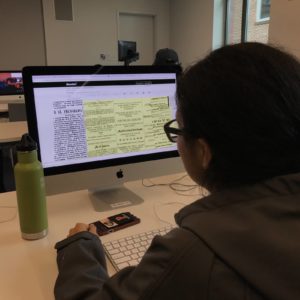While students usually choose to seek research internships over the summer, some research opportunities are also available during the semester, such as working under a professor or graduate student to aid with their academic research. However, among these choices, it may often feel like there are especially limited research opportunities available for students pursuing majors in the humanities or social sciences. We often imagine research assistants as collecting and analyzing statistical data, examining Petri dishes in a lab, developing computer programs, and so forth, and so we may be more skeptical as to what kind of research non-STEM majors could possibly partake in.
To learn more about research opportunities during the semester in the humanities and social sciences, I interviewed Emily Sanchez ’22, who is currently working as a research assistant under Professor Rosina Lozano. Professor Lozano, an Associate Professor of History at Princeton, specializes in Latino history and the study of Latino cities in the U.S. As a research assistant, Emily has been examining 19th-century Spanish newspapers from the Southwest to understand more about the historical ties between ethnic Mexicans and indigenous communities in the region.
Here’s what Emily shared about her experience as a research assistant:
What is your research about?
Professor Rosina Lozano’s research focuses on the relationship between ethnic Mexican communities and indigenous people in the Southwest. She is specifically looking at the development of this relationship from the mid-19th century up until the 1970s. It’s fascinating to look at this development because in the 1850s, many ethnic Mexican communities used dehumanizing and derogatory language when talking about indigenous populations, and later these same communities began to embrace their own mixed indigenous roots in the 1970s. As Professor Lozano’s research assistant, I’m concentrating on the nineteenth century and looking at Spanish/bilingual newspaper commenting on indigenous populations from New Mexico, Arizona, and parts of California.
How did you find out about this research opportunity?
In early August, I received an email from Professor Lozano informing me of the research assistant position. In this email, Professor Lozano detailed her research and the amount of time I would have to commit if I were to be one of her research assistants. I immediately said yes because I saw this position as an opportunity for me to gain more experience in history research and also fuel my passion for history.
How do you conduct your research on campus?

I conduct my research mainly by logging onto one of the databases that contain Spanish/bilingual newspapers from the Southwest, like the Hispanic American Newspapers database. Once on the database, I search key terms used typically in the nineteenth century to refer to indigenous peoples, like “indio,” to find newspapers that give insight into the relationship between ethnic Mexican communities and indigenous peoples. Once I do find these types of newspapers, I log them onto an excel sheet where I keep a record of all the other newspapers I have found so far and try to look for any patterns across the newspapers.
How do you manage your time commitment for this project with your schoolwork, extracurricular activities, etc.?
At the beginning of the semester, it was a bit of a challenge trying to manage my time, especially with the added commitment of research. However, now I carefully plan out my week, some days hour-by-hour, to make sure that I have enough time for my academic, extracurricular work, and research. I also like to spread out my research hours across the span of the week.
How has this influenced your interest in history?
Before researching this semester, I was unsure about whether I wanted to major in history or not. However, now that I have spent some time looking through databases, zooming into small print newspapers, and analyzing patterns, I know I definitely want to major in history. I really enjoy looking at these types of materials and finding patterns across time — I can see myself researching using a historical lens for my JP, thesis, and possibly beyond after college.
Emily’s experience shows how students can still pursue engaging research opportunities in non-STEM fields, as well as how they can effectively handle conducting research throughout the semester with their other time commitments. Especially for students in the humanities and social sciences, familiarizing yourself with your professors’ respective research would be a crucial step towards seeking opportunities in the fields you’re interested in.
–Soo Young Yun, Humanities Correspondent

